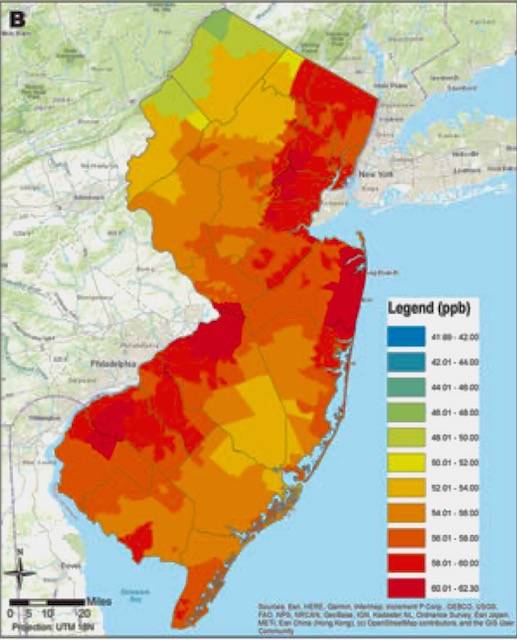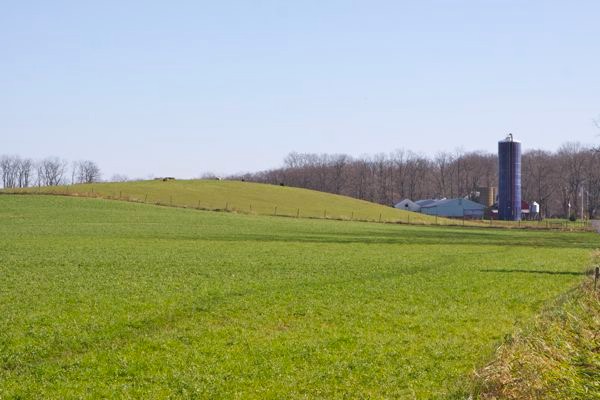The metal aluminum is highly toxic to aquatic life, especially pollution sensitive fish like trout.
For example, a USGS study in the nearby NY Catskills found that logging caused runoff to streams that killed 100% of trout, see:
The Clean Water Act requires that all surface waters be fishable and swimmable and mandates that US EPA adopt protective water quality standards (called “criteria”) for State’s to incorporate as regulatory standards.
EPA originally adopted an aluminum toxicity criteria in 1988, and recently updated it in 2018, see:
The DEP failed to adopt the original 1988 EPA aluminum criteria or the 2018 Update and is again flouting the Clean Water Act, ignoring the best available science, and failing to protect the ecological health of NJ waters and natural resources.
While DEP has failed to update NJ’s water quality standards to protect the ecological health of NJ’s streams and rivers, they did recently propose a broad “variance” loophole from those water quality standards, thereby protecting polluters not clean water, see:
So, we submitted a “petition for rulemaking” to force DEP’s hand and hold them accountable to law and science:
Subject: Joint Petition for rulemaking
Dear DEP Commissioner LaTourette; Pinelands Commission; and Highlands Council:
This letter petition is filed via email pursuant to N.J.S.A. 52:14B-4 (NJ APA), which provides that:
“(f) An interested person may petition an agency to adopt a new rule, or amend or repeal any existing rule. Each agency shall prescribe by rule the form for the petition and the procedure for the submission, consideration and disposition of the petition. The petition shall state clearly and concisely:
(1) The substance or nature of the rule-making which is requested;
(2) The reasons for the request and the petitioner’s interest in the request;
(3) References to the authority of the agency to take the requested action.”
This petition for rulemaking is submitted in accordance with the NJ APA and in substantial compliance with NJAC 7:1D-1 PETITIONS FOR RULES, and applicable Pinelands NJAC 7:50-7.3 Proposed amendments; petitions for amendment.
I hereby jointly petition the Department, the Pinelands Commission, and the Highlands Council for rulemaking as follows:.
(1) The substance or nature of the rule-making which is requested
New Jersey’s ecosystems, water resources, and natural resources are particularly vulnerable to the toxic effects of aluminum.
USGS research has documented 100% mortality of trout from aluminum, caused by forestry (logging).
Regarding NJ’s particular vulnerability, according to US EPA:
“In the early 1980s the impacts of acid rain and aluminum toxicity were observed in aquatic and terrestrial environments in specific regions of the U.S., most notably in the northeastern part of the country where aquatic systems had limited buffering capacity to prevent pH changes. Researchers observed that aluminum can be a major factor responsible for the demise of biotic communities since the toxicant becomes more soluble and potentially more toxic to aquatic biota at acidic pH (Gensemer and Playle 1999).” (Source: EPA, at page 10. LINK
https://www.epa.gov/sites/default/files/2018-12/documents/aluminum-final-national-recommended-awqc.pdf
EPA identified anthropogenic activities as important sources of aluminum to surface waters, including soil disturbance, erosion, and runoff.
Forest management activities, including logging, create soil disturbance that causes, among other things, liberation of inorganic monomeric aluminum via stormwater runoff, sediment transport, and erosion.
According to a United State Geologic Survey (USGS) scientific study in the nearby NY Catskills, logging activities adversely impact ecosystem health and water resources, including the toxic effects of aluminum, see:
- Effects of Forest Harvesting on Ecosystem Health in the Headwaters of the New York City Water Supply, Catskill Mountains, New Yor
https://pubs.usgs.gov/sir/2008/5057/SIR2008-5057.pdf
This USGS study found serious adverse impacts on water resources, aquatic life, and fisheries, including 100% mortality of Brook trout and adverse impacts on macro invertebrate communities : (emphases mine)
“Clearcutting caused a large release of nitrate (NO3 -) from watershed soils and a concurrent release of inorganic monomeric aluminum (Alim), which is toxic to some aquatic biota. The increased soil NO3 – concentrations measured after the harvest could be completely accounted for by the decrease in nitrogen (N) uptake by watershed trees, rather than an increase in N mineralization and nitrification. The large increase in stream water NO3 – and Al concentrations caused 100-percent mortality of caged brook trout (Salvelinus fontinalis) during the first year after the clearcut and adversely affected macroinvertebrate communities for 2 years after the harvest.”
The geology, forests, soils, atmospheric deposition, and water chemistry of the Catskills are similar to the NJ Highlands. (I hereby incorporate by reference NJ DEP NJGS research on Highlands geology and soils, US Forest Service studies on forests, soils, and water resources, and NJ DEP 305 (b) water quality inventory and assessment data, particularly the macro invertebrate impairment data and chemistry data on surface waters, including pH, total hardness, and DOC.).
I recently posed this question to USGS scientists.
According to Doug Burns of USGS, an author of that study: (personal communication, 9/22/22):
“Regarding your question about whether these results from the Catskills would also apply in the NJ Highlands. I have a few thoughts:
It will depend a lot on the stream chemistry. We sampled some streams in the NJ Highlands about 10+ years ago and scanning these data I see that there are some quite acidic streams as well as some well buffered streams. Streams that would be most relevant are those with slightly buffered conditions that could support a brook trout population but that would be sensitive to becoming more acidic after clearcutting. The extent to which the streams would be sensitive to harvesting is a function of how much nitrogen is stored in the soils and a critical ratio of carbon to nitrogen in those soils. The Catskill streams were poised to release a large amount of dilute nitric acid from the soils to the stream after harvesting. One factor that has changed since the 1990s is that atmospheric nitrogen deposition has declined markedly and it is likely that the stores of nitrogen in the soils have declined as well. Therefore, the release of dilute nitric acid today will likely be less severe than back in the 1990s. But we don’t know for sure. So in answer to your question, the same process and risk to brook trout could occur in NJ streams that are weakly or poorly buffered but it depends in part on how much nitrogen is stored in the soils relative to 25-30 years ago.”
In addition to USGS research, the US EPA comprehensively assessed the best available science on aluminum aquatic toxicity in their 2018 update of the 1988 EPA aluminum criteria, see:
FINAL AQUATIC LIFE AMBIENT WATER QUALITY CRITERIA FOR ALUMINUM
https://www.epa.gov/sites/default/files/2018-12/documents/aluminum-final-national-recommended-awqc.pdf
I hereby incorporate by reference the data, findings, and criteria recommendation from that EPA document in:
- “AQUATIC LIFE AMBIENT WATER QUALITY CRITERIA FOR ALUMINUM (2018)”
See especially the following sections of the EPA Technical Support Document:
- Section 1: Adopting the 2018 Recommended Aquatic Life Water Quality Criteria for Aluminum into State or Tribal Water Quality Standards
- Section 5: Implementing the Recommended Aluminum Criteria in National Pollutant Discharge Elimination System (NPDES) Permitting
- Section 6: Implementing the Recommended Aluminum Criteria in Assessments, Listings, and Total Maximum Daily Loads (TMDLs)
The EPA fact sheet on the aluminum criteria states:
“Aluminum is found in most soils and rocks. It is the third most abundant element and the most common metal in the earth’s crust. Aluminum can enter the water via natural processes, like weathering of rocks. Aluminum is also released to water by mining, industrial processes using aluminum, and in waste water and drinking water treated with alum, an aluminum compound. …
Aluminum is considered a non-essential metal because fish and other aquatic life do not need it to function. Elevated levels of aluminum can affect some species’ ability to regulate ions, like salts, and inhibit respiratory functions, like breathing. Aluminum can accumulate on the surface of a fish’s gill, leading to respiratory dysfunction, and possibly death.”
https://www.epa.gov/sites/default/files/2018-12/documents/aluminum-criteria-final-factsheet.pdf
I hereby incorporate by reference the USGS and EPA science, data, and EPA recommendations from the above referenced documents.
The above represents the best available science and they serve as an adequate scientific and regulatory basis in support of the petition.
(2) The reasons for the request and the petitioner’s interest in the request
The reasons for the request are as follows:
First of all, the NJ DEP currently has no surface water quality standards for aluminum, despite the fact that EPA adopted an aluminum criteria in 1988 and recently updated the criteria in 2018.
The DEP does not monitor or assess water quality or aquatic ecosystem health for the well known adverse ecological and water quality impacts of aluminum.
The DEP does not regulate the water quality and ecosystem impacts of forestry – or other development activities that generate non-point source pollution or point source wastewater discharges – including for the known toxic impacts of aluminum.
The DEP does not in any way regulate the presence of or discharge of aluminum to the environment: to soils, surface waters, wetlands, groundwaters or biota, despite the fact that there are known industrial point source wastewater discharges to surface waters and non-point pollutant discharges from development and stormwater runoff, including from forestry.
The same regulatory loopholes are present in the Pinelands CMP and Highlands RMP.
The reasons for the petition are to close these regulatory loopholes in order to:
- to assure protection of the ecological health of NJ’s water and natural resources, based upon the best available science
- to assure that forest management activities do not impair or adversely impact the water quality and/or aquatic life of NJ’s surface waters and wetlands
- to assure that NJ’s waters are fishable and swimmable, as required by the federal Clean Water Act and the NJ Water Pollution Control Act
- to assure that NJ DEP’s water quality standards, Highlands, freshwater wetlands, stormwater, and forest management policies and regulations are current, reflect the best available science, and conform to minimum federal standards, criteria, and guidance
- to assure protection of the Pinelands water and natural resources
- to assure protection of the Highlands water and natural resources
- to assure that the NJ DEP surface water quality standards’ anti-degradation policies are implemented, particularly for Category One Waters (C1), trout production (TP), and trout maintenance (TM) waters (see: NJAC 7:9B-1 et seq)
The petitioner’s interests are:
a) to promote the public trust doctrine,
b) to promote the public interest,
c) to preserve and protect ecosystems,
d) to assure compliance with law, and
e) to hold regulatory officials accountable to the best available science and applicable law.
The petitioner earned a Bachelor’s degree in environmental science and public policy (SUNY Binghamton, 1982) and satisfied the coursework requirements fo a Masters of Regional Planning degree from Cornell (1983-85). He served as an environmental planner and policy analysis for 13 years at NJ DEP (1985-1995; 2002 – 2004) and in various non-governmental environmental advocacy organizations for 15 years.
The petition is consistent with petitioner’s 35 year career interests.
(3) References to the authority of the agency to take the requested action
This joint petition if filed pursuant to the Department’s, Pinelands Commission’s, and Highlands Council’s various legal authorities and police powers, including but not limited to:
- The Highlands Act
- The Pinelands Act
- The DEP’s Organic Act (NJSA 13:1D-1 et seq.
- CAFRA
- Freshwater Wetlands Act
- NJ Water Pollution Control Act and delegated federal Clean Water Act
- NJ Water Quality Management Act
- Endangered Species Act
(4) Existing Federal or State statutes and rules which the petitioner believes may be pertinent to the request.
See above pertinent federal and State legislative authorities.
Pertinent regulations include those rules adopted to implement these authorities, including the Pinelands CMP and the Highlands RMP.
Pertinent federal and State DEP regulations include, but are not limited to:
- US EPA – Adopting the 2018 Recommended Aquatic Life Water Quality Criteria for Aluminum into State or Tribal Water Quality Standards
- US EPA – Implementing the Recommended Aluminum Criteria in National Pollutant Discharge Elimination System (NPDES) Permitting
- US EPA – Implementing the Recommended Aluminum Criteria in Assessments, Listings, and Total Maximum Daily Loads (TMDLs)
- NJ DEP Surface Water Quality Standards (NJAC 7:9B)
- NJ DEP Freshwater Wetlands Regulations (NJAC 7:7A)
- NJ DEP Stormwater Management Regulations (NJAC 7:8)
- NJ DEP NJPDES Regulations (NJAC 7:14, NJAC 7:14A)
- NJ DEP Water Quality Management Regulation (NJC 7:15)
- NJ DEP Highlands Regulations (NJAC 7:38)
- CAFRA (NJAC 7:7)
- NJ DEP Forestry Wetlands BMP Manual
- NJ DEP Forestry Regulations (NJAC 7:3)
- NJ DEP Water Quality Monitoring And Assessment Clean Water Act Section 303(d) and 305(b) programs
- Recent pertinent federal regulations and science include, but are not limited to the US EPA “Final AQUATIC LIFE AMBIENT WATER QUALITY CRITERIA FOR ALUMINUM (2018)”.
(5) The wording of any proposed amendment of the text of this Plan and a map depicting any proposed change to the Pinelands Land Capability Map;
This Pinelands CMP requirement is not applicable, because the petition involves surface water quality standards, not land use mapping.
The specific text of the surface water quality standards that would serve as an amendment to the CMP is found in the US EPA’s “Final AQUATIC LIFE AMBIENT WATER QUALITY CRITERIA FOR ALUMINUM (2018)”
(6) A statement of the need and justification for the proposed amendment, including the reason(s) why the goals which the proposed amendment is intended to achieve cannot be accomplished through adherence to the standards of this Plan or compliance with the procedures set forth in N.J.A.C. 7:50-4, Part V;
The text above provides the scientific and regulatory basis (i.e. “justification”) for the proposed CMP amendment.
The reason why the goals can not be achieved via adherence to the CMP is because the CMP and the the DEP water quality standards and Water quality monitoring and assessment programs do not include aluminum criteria or aluminum toxicity monitoring and assessment.
(7) A statement as to the conformity of the proposed amendment to the goals and objectives of this Plan and the intent of the Pinelands Protection Act and the Federal Act;
The petition is consistent with and advanced the following goals, objectives, standards and programs of the Pinelands Protection Act and the federal Act (my emphases):
“The Legislature hereby finds and declares that the pinelands area comprises pine-oak forests, cedar swamps, and extensive surface and ground water resources of high quality which provide a unique habitat for a wide diversity of rare, threatened and endangered plant and animal species and contains many other significant and unique natural, ecological, agricultural, scenic, cultural and recreational resources; that the continued viability of such area and resources is threatened by pressures for residential, commercial and industrial development; that the protection of such area and resources is in the interests of the people of this State and of the Nation; that such protection will require the coordinated efforts of all relevant municipal, county, State and Federal agencies; that the Congress and President of the United States have demonstrated a recognition of these facts through the enactment of section 502 of the “National Parks and Recreation Act of 1978” (PL 95-625); and, that it is now necessary to implement the afore-cited Federal Act and insure the realization of pinelands protection through the establishment of a regional planning and management commission empowered to prepare and oversee the implementation of a comprehensive management plan for the pinelands area.
The Legislature further finds and declares that a certain portion of the pinelands area is especially vulnerable to the environmental degradation of surface and ground waters which would be occasioned by the improper development or use thereof; that the degradation of such waters would result in a severe adverse impact upon the entire pinelands area;”
The petition seeks to protect ecological integrity, preserve water quality, and prevent degradation of water quality by development activities that disturb soils and result in toxic pollution of the Pinelands.
The petition is consistent with and advances the same goals, objectives, purposes and standards of the CMP, including:
- PART I-TITLE. AUTHORITY, PURPOSE
- PART II-DUTIES AND POWERS OF THE COMMISSION
- PART III-DUTIES AND POWERS OF THE EXECUTIVE DIRECTOR
- PART I-WETLANDS
- PART III-FISH AND WILDLIFE
- PART IV-FORESTRY
- PART VIII-WATER QUALITY
- PART XIV-RECREATION
- SUBCHAPTER 8. ENFORCEMENT
(8) If the proposed amendment would change the minimum standards for land use and intensities contained in N.J.A.C. 7:50-5 or the management programs and minimum standards contained in N.J.A.C. 7:50-6, an evaluation of the environmental consequences of the proposed change;
This provision of the CMP amendment rules is not applicable. The petition does not involve land use intensities or minimum standards.
The environmental consequences of the petition would be improved water quality, ecosystem health, and forest management practices.
(9) If the proposed amendment involves the redesignation of Pinelands management areas for a particular parcel, documentation as to how the affected parcel meets the criteria established in this Plan for the management area to which it is proposed to be redesignated. Unless the Commission determines that it is unnecessary, any such amendment shall include a proposal for an offsetting management area change and documentation as to how all of the lands affected by the offset proposal meet the criteria established in this Plan for the management area to which they are proposed to be redesignated.
This provision of the CMP rules is not applicable because the petition does not predesignate parcels of land or management areas.
(10) Any other information necessary or appropriate for full and proper consideration of the proposed amendment.
The recently released Pinelands research on ecological impacts of endocrine disruptors is relevant because is documents the impacts of land disturbance and land use on the toxic ecological and water quality impacts of chemicals.
Similar to endocrine disruptors, aluminum is liberated and released into ecosystems and water resources by land disturbance, including regulated development and forest management.
(11) Specific regulatory actions requested
I request the following specific regulatory amendments:
A) NJ DEP
1. Amend the NJ Surface Water Quality Standards, NJAC 7:9B – 1 et seq., to adopt an aquatic protection criteria for acute and chronic effects of aluminum, at least as stringent as, and consistent with, the US EPA Final Criteria (2018) cited above.
2. Amend the Highlands, NJPDES, WQMP, TMDL, and Stormwater management regulations to mandate compliance with the aluminum criteria (water quality standards)
3. Revise the Forestry Wetlands BMP to mandate monitoring and compliance with the proposed aluminum criteria.
4. Revise the DEP’s Water Quality Monitoring And Assessment Program under Clean Water Act Section 303(d) and 305(b) to include aluminum.
5. Revise the forestry regulations to include monitoring and compliance with the aluminum criteria.
6. Revise all the regulations cited above for conformity with the EPA aluminum criteria pending adoption of a NJ DEP State criteria.
B) Pinelands Commission
Amend the CMP to require monitoring and compliance with the EPA’s Final aluminum criteria cited above for regulated activities that disturb soils, generate stormwater, and/or result in point and non-point discharge of pollutants to wetlands and surface waters, including development and forest management activities.
C) Highlands Council
Amend the RMP to require monitoring and compliance with the EPA’s Final aluminum criteria cited above for regulated activities that disturb soils, generate stormwater, and/or result in point and non-point discharge of pollutants to wetlands and surface waters, including development and forest management activities.
Respectfully submitted:
Bill Wolfe





